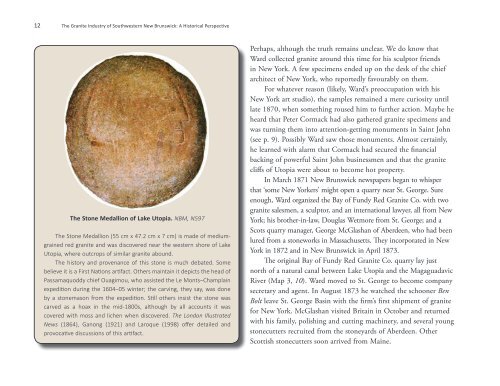The Granite Industry of Southwestern New Brunswick: A Historical ...
The Granite Industry of Southwestern New Brunswick: A Historical ...
The Granite Industry of Southwestern New Brunswick: A Historical ...
Create successful ePaper yourself
Turn your PDF publications into a flip-book with our unique Google optimized e-Paper software.
12 <strong>The</strong> <strong>Granite</strong> <strong>Industry</strong> <strong>of</strong> <strong>Southwestern</strong> <strong>New</strong> <strong>Brunswick</strong>: A <strong>Historical</strong> Perspective<br />
<strong>The</strong> Stone Medallion <strong>of</strong> Lake Utopia. NBM, N597<br />
<strong>The</strong> Stone Medallion (55 cm x 47.2 cm x 7 cm) is made <strong>of</strong> mediumgrained<br />
red granite and was discovered near the western shore <strong>of</strong> Lake<br />
Utopia, where outcrops <strong>of</strong> similar granite abound.<br />
<strong>The</strong> history and provenance <strong>of</strong> this stone is much debated. Some<br />
believe it is a First Nations artifact. Others maintain it depicts the head <strong>of</strong><br />
Passamaquoddy chief Ouagimou, who assisted the Le Monts–Champlain<br />
expedition during the 1604–05 winter; the carving, they say, was done<br />
by a stonemason from the expedition. Still others insist the stone was<br />
carved as a hoax in the mid-1800s, although by all accounts it was<br />
covered with moss and lichen when discovered. <strong>The</strong> London Illustrated<br />
<strong>New</strong>s (1864), Ganong (1921) and Laroque (1998) <strong>of</strong>fer detailed and<br />
provocative discussions <strong>of</strong> this artifact.<br />
Perhaps, although the truth remains unclear. We do know that<br />
Ward collected granite around this time for his sculptor friends<br />
in <strong>New</strong> York. A few specimens ended up on the desk <strong>of</strong> the chief<br />
architect <strong>of</strong> <strong>New</strong> York, who reportedly favourably on them.<br />
For whatever reason (likely, Ward’s preoccupation with his<br />
<strong>New</strong> York art studio), the samples remained a mere curiosity until<br />
late 1870, when something roused him to further action. Maybe he<br />
heard that Peter Cormack had also gathered granite specimens and<br />
was turning them into attention-getting monuments in Saint John<br />
(see p. 9). Possibly Ward saw those monuments. Almost certainly,<br />
he learned with alarm that Cormack had secured the financial<br />
backing <strong>of</strong> powerful Saint John businessmen and that the granite<br />
cliffs <strong>of</strong> Utopia were about to become hot property.<br />
In March 1871 <strong>New</strong> <strong>Brunswick</strong> newspapers began to whisper<br />
that ‘some <strong>New</strong> Yorkers’ might open a quarry near St. George. Sure<br />
enough, Ward organized the Bay <strong>of</strong> Fundy Red <strong>Granite</strong> Co. with two<br />
granite salesmen, a sculptor, and an international lawyer, all from <strong>New</strong><br />
York; his brother-in-law, Douglas Wetmore from St. George; and a<br />
Scots quarry manager, George McGlashan <strong>of</strong> Aberdeen, who had been<br />
lured from a stoneworks in Massachusetts. <strong>The</strong>y incorporated in <strong>New</strong><br />
York in 1872 and in <strong>New</strong> <strong>Brunswick</strong> in April 1873.<br />
<strong>The</strong> original Bay <strong>of</strong> Fundy Red <strong>Granite</strong> Co. quarry lay just<br />
north <strong>of</strong> a natural canal between Lake Utopia and the Magaguadavic<br />
River (Map 3, 10). Ward moved to St. George to become company<br />
secretary and agent. In August 1873 he watched the schooner Ben<br />
Bolt leave St. George Basin with the firm’s first shipment <strong>of</strong> granite<br />
for <strong>New</strong> York. McGlashan visited Britain in October and returned<br />
with his family, polishing and cutting machinery, and several young<br />
stonecutters recruited from the stoneyards <strong>of</strong> Aberdeen. Other<br />
Scottish stonecutters soon arrived from Maine.
















